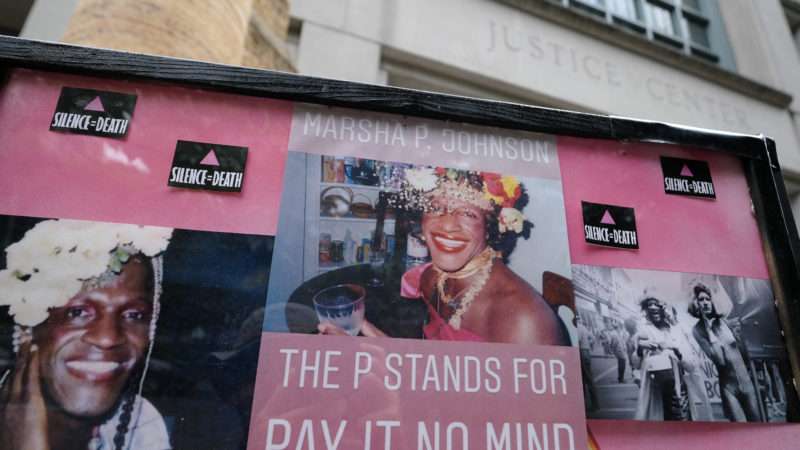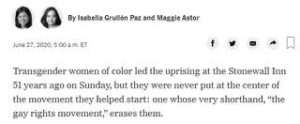
Head over to Google today and you’ll see one of its famous doodle sketches in the form of Marsha P. Johnson, the LGBT rights activist, with her signature flower crown, gender-bending ensemble, and wide smile.
In recent years, Johnson has been credited as a “trans woman of color” who started the Stonewall Riots and thus, in some sense, the LGBT rights movement. While it’s undeniable that she was a charismatic central figure in that story, it’s far from clear that she was one of the main instigators at Stonewall. Even more fraught: It’s far from clear she was trans.
On one level, it doesn’t really matter. She was an inspiring person who fought for civil rights despite huge obstacles in her way, and that’s enough to celebrate. But being on the right side of history—as so many activists in the intersectional social justice space believe they are—doesn’t give you license to rewrite it. In the end, the facts matter, even when they are slightly less convenient for your narrative.
In the early morning hours of June 28, 1969, New York City police officers descended on the Stonewall Inn to conduct what had become their typical, humiliating, and brutal raids on gay establishments. Patrons weren’t having it. Several days of riots followed.
In popular culture, the Stonewall Riots are widely viewed as pivotal. But there’s also a mythic air to the protests. Folkloric tellings and retellings change with each passing year: Who spearheaded the charge against authority? Who threw that fateful first brick? Or was it a shot glass?
The answers to those questions largely remain unanswered, but in recent years one narrative has taken hold. The claim that it was “trans women of color“—especially Johnson—who led the uprising has been repeated uncritically by politicians, pundits, and in the national media.
But it isn’t difficult to figure out that the Stonewall riots did not begin with Johnson. For one thing, Johnson said so herself. “I was uptown and I didn’t get downtown until about two o’clock. When I got downtown, the place was already on fire, and there was a raid already,” she told historian Eric Marcus in 1987. “The riots had already started.”
Yet in recent years, an alternate narrative has shifted from urban legend to indisputable fact. Johnson was “one of three individuals” who first “incited pushback against police,” writes Rolling Stone. “It started when Marsha P. Johnson cried ‘I got my civil rights!’ and threw a shot glass into a mirror,” says a Forbes contributor, whose piece was selected and promoted as an Editors’ Pick.
“Transgender women of color led the uprising at the Stonewall Inn 51 years ago on Sunday,” The New York Times claimed, though the paper later ghost-edited that line and appended a correction.
What’s more, there’s no evidence Johnson used the term transgender for herself. Though it’s true that the term was not nearly as widespread as it is today, it wasn’t unheard of. And Johnson—who used both “he” and “she” pronouns, and wore both male and female clothing—identified as a drag queen, as well as “gay” and as a “transvestite.” To conflate those identities with transgenderism trivializes and misappropriates the unique struggles those communities face.
Intersectionality—while built around the well-intentioned idea that we should be vigilant and caring toward society’s most vulnerable—can end up encouraging activists to prioritize identity at the expense of the truth. Saying your movement was started by a “transgender woman of color” checks a lot of boxes and confers the proper legitimacy on your cause.
Exactly how Johnson identified shouldn’t really be the main focus, though present-day activists have placed undue emphasis on it. Johnson was a determined activist for the cause and a founding member of the Gay Liberation Front.
We could all stand to learn from Johnson, whose chosen middle initial—”P”—stood for “Pay it no mind,” a common response she’d give those who’d inquire about her gender. She begged not to be put into a box. Today’s activists have done the opposite.
On a broader level, such retroactive reimagining of history makes it hard to actually learn from the past. “Stonewall Inn was not a very hospitable place to those who were then referred to as transsexuals or transvestites,” says James Kirchick, a visiting fellow at the Brookings Institution. “A lot of gay bars were segregated in that way, and a lot of gay bars were racially segregated, maybe not officially or legally, but unofficially certainly.” Those like Johnson, then, were often rejected by the community they wanted to join. Members of that same community have now co-opted and reimagined Johnson for their own purposes.
Put differently, you could say Johnson was likely one step ahead of her peers. But that was because she understood what it was like not to have a seat at the table, much less to be at the head of it. “In some ways,” writes journalist Andrew Sullivan at New York, “it was the rebellion of those with much more to lose that marked a shift in consciousness.”
Perhaps ironically, the left has often led the charge against attempts to change history and decried the effects of such revisionism. When it comes to the debate around Confederate monuments, for instance, many left-leaning folks have rightly resisted false portrayals surrounding the circumstances in which those statues were erected. To rewrite the Civil War narrative, they say, is to erase a savage history of human suffering, one that we’re still trying to learn from today.
It’s for that same reason that Johnson’s history—her actual history, to the extent that we can know it—should be told truthfully, and in full.
from Latest – Reason.com https://ift.tt/2VAzv7Q
via IFTTT